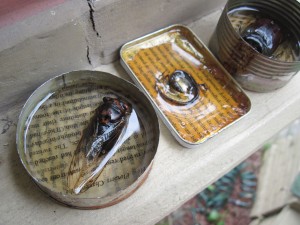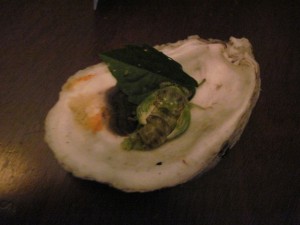|
There are many things we will remember about this summer. It’s the 5th annivesary. It’s unusually hot and swampy. It follows a frigid winter that killed a lot of outdoor vegetation (rubber trees taking it particularly bad). What is unique for me is the morning and evening chorus of cicadas is the loudest I have ever heard. It overcomes everything – the pneumatic nail guns, the thumping car stereos, the “Comin’ ‘Round The Mountain” synthesized ice cream truck song. It’s also very tight. As in tight like a Jazz band. Unified. They are all hitting all their marks. They are abruptly stopping when all the others do, then slowly, one-by-one, working themselves back into the frenzy of the next track. I’ve also seen more of them. Both dead and alive. I was under the backyard willow tree last week and one was flying from spindly branch to spindly branch. I only knew he was there because the usually far off and consolidated sound they make was isolated and very close. And very loud. I’ve also seen more dead cicadas and have been transforming them into art… The other night while barbecuing, my dog Doris (a notorious snouter and locater of buried and hiding creatures) was pawing at the ground and upon investigating we came upon an injured molting cicada. I placed it in an oyster shell and put it in the herb garden up front but it was dead the next day sad to say. We had a little wake for it with sweet coffee and some Nick Cave / Warren Ellis compositions. |
Here is a great animated gif of a molting cicada…

And some stuff I found interesting …
Some species of cicada also have an unusual defense mechanism to protect themselves from predation, known as predator satiation: by many emerging at once, whereas there are no cicadas around for much of the year, essentially, the number of cicadas in any given area exceeds the amount predators can eat; all available predators are thus satiated, and the remaining cicadas can breed
Some species have much longer life cycles, such as the North American genus, Magicicada, which has a number of distinct “broods” that go through either a 17-year or, in the South of the USA, a 13-year life cycle.
Male cicadas have loud noisemakers called “timbals” on the sides of the abdominal base. Their “singing” is not the stridulation (where two structures are rubbed against one another) of many other familiar sound-producing insects like crickets: the timbals are regions of the exoskeleton that are modified to form a complex membrane with thin, membranous portions and thickened “ribs”. Contracting the internal timbal muscles produces a clicking sound as the timbals buckle inwards. As these muscles relax, the timbals return to their original position producing another click. The interior of the male abdomen is substantially hollow to amplify the resonance of the sound. A cicada rapidly vibrates these membranes, and enlarged chambers derived from the tracheae make its body serve as a resonance chamber, greatly amplifying the sound.
They are also known as “jar flies” and, regionally, as July flies[2] in the Southeastern United States, and as “heat bugs” in Canada and the mid-West.



I’d be really interested in seeing how the cicada art came out. I keep seeing the shells on my white picket fence and I just leave them clinging because they look so cool.
I will try to post an image of it when I am done. Right now I am having a hard time getting the epoxy to dry.
We were in St. Bernard State Park this morning and saw some giant black grasshoppers with red marks. Never seen them before (I’m from New England) and I thought of collecting some dead ones for mounting or encapsulating like you’ve done here with cicadas. Nice work. WK
Those grasshoppers are crazy huge! They are down in Lafitte too. They are bigger than some small rodents. # inches tall at the knee cap at least. When I master the resin I’ll let you know the best way to do it. I am having a hard time getting the pictured ones to dry.
Awesome! Here on the northshore the cicadias are strangely silent this summer. Perhaps the cold winter killed all of the babies. I remember last summer my hunter cat was bringing in the damn things every morning and torturing the poor things. Luckily my husband was there to pick the cidadias up and throw them back outside while leaving the “bad kitty” inside.